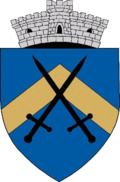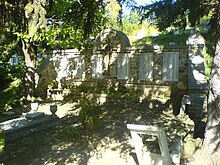Șura Mare
|
Şura Mare United chafing Nagycsűr |
||||
|
||||
| Basic data | ||||
|---|---|---|---|---|
| State : |
|
|||
| Historical region : | Transylvania | |||
| Circle : | Sibiu | |||
| Coordinates : | 45 ° 51 ' N , 24 ° 9' E | |||
| Time zone : | EET ( UTC +2) | |||
| Height : | 450 m | |||
| Area : | 74.85 km² | |||
| Residents : | 3,769 (October 20, 2011) | |||
| Population density : | 50 inhabitants per km² | |||
| Postal code : | 557265 | |||
| Telephone code : | (+40) 02 69 | |||
| License plate : | SB | |||
| Structure and administration (as of 2016) | ||||
| Community type : | local community | |||
| Structure : | Șura Mare, Hamba | |||
| Mayor : | Cornel-Liviu Marin ( PSD ) | |||
| Postal address : | Str. Principală, no. 252 loc. Șura Mare, jud. Sibiu, RO-557265 |
|||
| Website : | ||||
Şura Mare ( German large scouring , Saxon Griußscheiern , latin Magnum Horreum , Hungarian Nagycsűr is) a location in Transylvania ( Romania ).
location
Șura Mare is located in the district of Sibiu , seven kilometers northeast of the district capital Sibiu ( Hermannstadt ) on the national road DN 14, which leads to Mediaș .
History and present
Early history
Großschüsten was first mentioned in 1337 as Magnum Horreum in a papal tax list and is one of the oldest parishes around Sibiu. The Hungarian name Nagycsür can be traced back to 1445; In 1468 the German name Großschewren was used for the first time , which was later slightly modified to get the current form Großschewren in the second half of the 19th century . The Romanian name Șura Mare is mentioned for the first time in a document from 1854 .
The village was destroyed and plundered several times: in 1529 by troops from the Vltava , in 1600 by Mihai Viteazul and in the early 18th century several times by the Kuruc .
Nevertheless, the villagers had already recovered from the chaos of war in the first third of the 18th century, so that they formed the main taxpayers of the Hermannstadt See .
Schoolchildren were mentioned in Großschänen as early as 1512. Repair costs for the school building were recorded in 1724 and 1748. Since the growing number of children could no longer be accommodated in the old school building, a new school was built in 1863 for 8,400 guilders .
In 1905 a large and modern community hall was opened; In 1907 the community was connected to the electrical power grid.
Younger story
During the First World War , minor battles between Austrian and Romanian units took place in October 1916 in the municipality. The majority of the residents fled. The war killed 48 villagers.
During the Second World War , Soviet troops marched through the municipality in autumn 1944. German fighter planes then bombed the village. This caused great damage. The residents were again forced to flee and did not return to their looted houses until a few weeks later.
Until the end of the war, various Soviet military units and a horse field hospital were housed in the village. Their exact number is not known, but it ran into the thousands: around a hundred men were quartered on every Saxon court. The emaciated and neglected soldiers destroyed large parts of the parish, school and music archive as well as the school library by using valuable documents to heat the building.
On January 13, 1945 and the following days, 223 men and women were deported to the Soviet Union , of which 21 men and one girl died in the deportation. At the end of the Second World War, the Transylvanian Saxons had 105 war victims in Großscheuert.
The German population was almost completely expropriated by the Land Reform Act of March 23, 1945 .
Demographic statistics
| 1880 | 1930 | 1939 | |
|---|---|---|---|
| German | 981 | 1492 | 1718 |
| Romanians | 573 | 703 | 843 |
| Roma | 111 | 138 | --- |
| Hungary | 3 | 10 | --- |
| Others | 22nd | --- | --- |
| total | 1690 | 2343 | 2561 |
The German population in Șura Mare was
- 1945: 1200
- 1964: 1537
- 1989: 700
- 1990: 180
According to the 2002 census , 3,309 people lived in Șura Mare parish, which also includes Hamba village . 3102 were Romanians, 141 were Roma, 50 were Transylvanian Saxons, 14 Hungarians and one each described himself as a Greek and one as a Lipowan .
Attractions
The Evangelical Church, built in 1238 as a three-aisled, Romanesque basilica with a west tower, destroyed in the Turkish wars, modifications to a fortified church in Gothic style around 1500, baroque altar (1744), renovation 1980–1982.
Charitable
Since May 1st, 2009 the Șura Mare elementary school has had a day care center for children in need. Here, 15 children of the Roma ethnic minority and 17 Romanian children receive a warm meal and educational support. They also receive psychological care, as many of them have severe psychosocial trauma. The initiators are the Asociația Speranță și Sâmbet and the Children's Aid Association for Transylvania . Since 2011 the day center for 35 children called "Pippi Longstocking" has been housed in a rented house in Sibiu.
Personalities
- Goblinus (14th century), Catholic bishop of Karlsburg (1376–1386)
- Hieronymus Ostermayer (* ~ 1500–1561), scholar and organist
- Johann Haupt (17th century), was chair judge in Sibiu from 1670 to 1675, mayor from 1678 to 1685 and royal judge from 1685 to 1686
See also
Web links
- Șura Mare at ghidulprimariilor.ro
- Large scrubbing on www.siebenbuerger.de
- Johann Grau: Großschubbing , in the Siebenbürgische Zeitung, October 28, 1995
- Private web presentation of Großschubbing
Individual evidence
- ↑ 2011 census in Romania at citypopulation.de
- ↑ Data on the ethnic groups 2002 (Hungarian)
- ↑ Web presentation of Kinderhilfe für Siebenbürgen eV
- ↑ Information on Goblinus at sevenbuerger.de
- ↑ George Michael Gottlieb von Herrmann: The old Kronstadt. A Transylvanian town and country history up to 1800 (= writings on the geography of Transylvania. Vol. 32). Edited by Bernhard Heigl and Thomas Șindilariu. Böhlau, Cologne et al. 2010, ISBN 978-3-412-20439-6 , p. 393.







